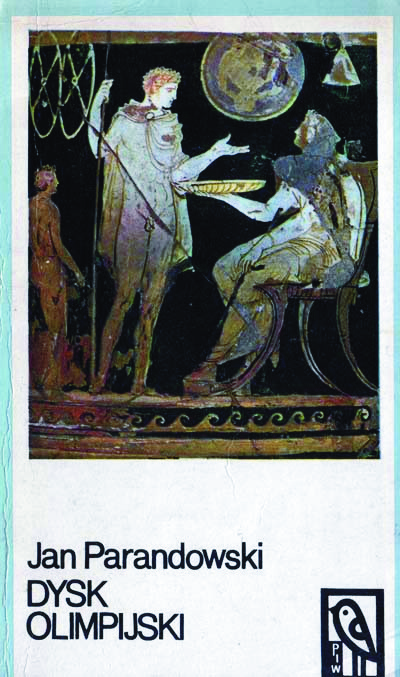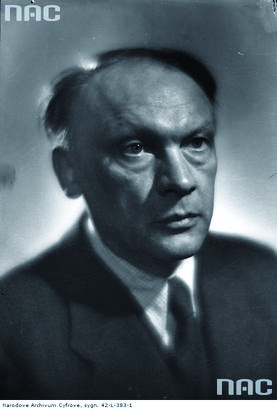Title of the work
Country of the First Edition
Country/countries of popularity
Original Language
First Edition Date
First Edition Details
Jan Parandowski, Dysk olimpijski. Warszawa: Gebethner i Wolff, 1933, 298 pp.
ISBN
Available Onllne
docer.pl (accessed: December 30, 2020)
Awards
1936 – Bronze medal in category Literature, Epic works at the Art competitions at the 1936 Summer Olympics in Berlin.
Genre
Historical fiction
Juvenile fiction*
Novels
Teen fiction*
Target Audience
Crossover
Cover

Cover from the edition Warsaw: Państwowy Instytut Wydawniczy, 1972.
Author of the Entry:
Summary: Joanna Grzeszczuk, University of Warsaw, joannagrzeszczuk1@gmail.com
Analysis: Marta Pszczolińska, University of Warsaw, m.pszczolinska@al.uw.edu.pl
Peer-reviewer of the Entry:
Katarzyna Marciniak, University of Warsaw, kamar@al.uw.edu.pl
Elżbieta Olechowska, University of Warsaw, elzbieta.olechowska@gmail.com

Photograph by Edward Hartwig, retrieved from the National Digital Archives.
Jan Parandowski
, 1895 - 1978
(Author)
Classical philologist and archaeologist. An outstanding and prolific author of books related to Antiquity; translator of classical masterpieces. Contributed to many Polish newspapers and magazines. Chairman of the Polish PEN Club from 1933 to 1978. Recipient of prizes for outstanding literary achievements, such as a bronze medal received at the 1936 Berlin Summer Olympics for his book Dysk olimpijski [Olympic Discus]. Member of the European Society of Culture. In 1962 he was elected Vice-President of the International PEN. An exceptionally successful supporter and advocate of Classical Antiquity in Poland. His Mitologia. Wierzenia i podania Greków i Rzymian [Mythology. Beliefs and Legends of the Greeks and Romans], still often read even in primary school, remains for many generations of Polish readers a fundamental source of the knowledge of ancient myths.
Major works: Eros na Olimpie [Eros on the Olympus], 1924, Mitologia. Wierzenia i podania Greków i Rzymian [Mythology. Beliefs and Legends of the Greeks and Romans], 1924; Wojna trojańska [Trojan War], 1927; Oscar Wilde’s biography Król życia [A King of Life], 1930; Dysk olimpijski [Olympic Discus], 1933; Niebo w płomieniach [Heaven in Flames], 1936; Trzy znaki zodiaku [Three Signs of the Zodiac], 1938; Godzina śródziemnomorska [The Mediterranean Hour], 1949; a study on creative writing Alchemia słowa [Alchemy of the Word], 1951. He also translated into Polish Caesar’s Civil War, 1951, and Homer’s Odyssey, 1953.
Sources:
Krełowska, Danuta, Jan Parandowski: życie i twórczość, Toruń: Wojewódzka Biblioteka Publiczna i Książnica Miejska im. M. Kopernika, 1989.
Paciorkowska, Monika, Jan Parandowski, slideshare.net (accessed: December 30, 2020).
"Parandowski Jan", in Jadwiga Czachowska and Alicja Szałagan, eds., Współcześni polscy pisarze i badacze literatury. Słownik biobibliograficzny, vol. 6: N–P, Warszawa: Wydawnictwa Szkolne i Pedagogiczne, 1999, 254–260.
"Parandowski, Jan", in Encyklopedia PWN, encyklopedia.pwn.pl (accessed: December 30, 2020).
wikipedia.org (accessed: December 30, 2020).
Życiorys Jana Parandowskiego, kul.pl (accessed: December 30, 2020).
Bio prepared by Joanna Grzeszczuk, University of Warsaw, joannagrzeszczuk1@gmail.com
Translation
Czech: Olympijský disk: roman, trans. Vojtěch J. Kosnar, Praha: L. Mazáč, 1937.
English: The Olympic discus, trans. A. M. Malecka and S. A. Walewski, London: Minerva Publishing, 1939.
German: Der olympische Diskus, trans. Alfred Loepfe, Berlin: Rütten & Loening, 1958.
Hungarian: Olimpia tüze, trans. Bába Mihaly, Budapest: Sport, 1963.
Lithuanian: Olimpijos diskas, trans. Dominykas Urbas, Vilnius: Vaga, 1984.
Romanian: Discul olipmpic, trans. Eugenia Vişinoiu, Bucureşti: Sport-Turism,1986.
Russian: Olimpijskij disk, trans. S. Larina, Moskva: Progress, 1979.
Serbian: Disk olimpijski, trans. Petar Vujičić, Beograd: Prosveta, 1963.
Slovak: Olympijský disk, trans. R. Turna, Praha: Melentrich, 1972.
Summary
Based on: Katarzyna Marciniak, Elżbieta Olechowska, Joanna Kłos, Michał Kucharski (eds.), Polish Literature for Children & Young Adults Inspired by Classical Antiquity: A Catalogue, Faculty of “Artes Liberales”, Warsaw: University of Warsaw, 2013, 444 pp.
First Olympic Games after the wars with Persia, the 76th Olympiad (476 B.C.). Contestants come to Elis at least one month before the games to train at the local gymnasium and be screened by the judges. The plot focuses on two characters: Sotion, who represents the old Olympic tradition, and Ikkos, who uses his body as a tool to reach his goal and considers athletics as a profession. Misunderstood by the other contestants, he disregards their jokes and follows strict rules concerning his daily schedule, workout, meals and many treatments that in his opinion are necessary to be properly prepared for the Olympics. When contestants come to Olympia, it turns out that talent without the effort of preparation is not enough. Ikkos wins at the Olympics, in the final contest he defeats the surprised Sotion.
Analysis
The novel is set in Greek antiquity in Elis and Olympia before and during the first Games after the Persian Wars; it focuses on displaying the main characters against a rich and detailed cultural background. Parandowski uses his profound philological and historical knowledge to create a faithful representation of ancient reality and creates reliable psychological portraits of Sotion and Ikkos, both from Taranto/Taras, and their opposite approaches to sports and life. Written with the epic Olympic contest in mind, the novel is a development of man, his values, virtues and vices, under the pressure of hard training required to achieve a precious goal and to fulfil one’s dreams. In this world of men, old Demaretos of Heraea/Heraia is an iconic image and a symbol of man’s highest happiness: he is an Olympic champion in hoplitodromos and father and grandfather of Olympic champions in pentathlon and Greek wrestling, pale. According to the traditional criteria, Sotion represents the Games’ true spirit as he is fully engaged with his body, mind, and soul. He is spontaneous, bright, enjoys sport in itself and competes for competition’s sake. His training is natural, full of passion, enthusiasm, joy, vital strength and power of youth. The fair play approach is also represented by another contestant, Agesidamos, who, having knocked out his opponent, opens his victorious fist and helps the loser stand up. The situation inspired Pindar to compose two of his epinikia (Pind. O., 10 & 11). Ikkos, however, represents a completely different approach. Focused on himself, he treats his body as an instrument to achieve the goal which is not simply the joy of competition itself, the wreath and future everlasting fame, but rather countable economical profits: money, honours, and allotments. Everything he does he considers and measures in detail: the quality and quantity of the trainings, use of massage oil and massage itself, eating balanced meals, duration of sleep, the temperature of water to drink or even exposure to sun rays. His vision of the sport becomes professional, which can be easily paralleled in modern Olympic Games and sports of the 20th century.
The richness of the Ancient Greek world is depicted in its diversity and details. Parandowski describes, not only the athletic aspects of the ancient Greeks’ lives, but also other aspects of their culture: their customs, beliefs, rites, superstitions, and celebrations. As the Games are panhellenic, contestants from all over the Greek-speaking world are summoned in the spirit of ekecheiria to the sacred place, free of feuds, but not of mutual common prejudices and stereotypes. Fortunately, despite differences in dialectical vocabulary and in particular, customs of their poleis, the participants follow the rules and find a common language of sport practiced for pleasure and prestige. The author touches on the issue of social status, wealth, and slavery associated with it. What is worth mentioning is that the diegetic world of the novel is completely male as the only woman allowed to watch the games is the priestess of Demeter Chamyne. The only other female character presented is the daughter of Scyllis of Scione, Hydna, a heroic swimmer and diver who cut the anchors of the Persian fleet damaging the ships and delaying the battle of Artemisium (480 B.C.). Parandowski shortly recounts her story based on Pausanias (10.19.1–2).
The action is realistic and proceeds in the natural sequence of preparation (part one taking place in Elis) and then the course (part two taking place in Olympia) of the Olympic competition 476 B.C., as it really happened. The author also involves some historical figures, like Pindar, Themistocles, Hieron of Syracuse, or Alexander I of Macedon, son of Amyntas, and evokes references to Persian war hostilities and warfare, based on ancient sources. Similarly, the names of secondary characters and the contestants presented in the novel are authentic.
As the characters are shown to be flesh and blood, Greek mythology references are mainly present as a part of their life and culture in all its rich diversity. Having seen large-footed tracks of Gerenos of Naucratis, the contestants talk about Heracles and the tales about him in different regions. They also discuss the character of Helios, when Sotion asks, whether Helios holds his shield in his hand or on his back. Besides, Parandowski describes Selene and her multiple projections, images and names as the arriving pilgrims go to sleep at moonset. The sight of the Pelopion Tumulus evokes the myth of Oenomaus and Hippodamia as connected, according to Ikkos, to the mythical beginnings of the Games. Other contestants argue with him, thinking that it was Heracles who established the Games. In fifth-century Greece, even some animals have mythical genealogy – horses readied for races are believed to be descendants of horses broken in by Hippolytus and of Diomedes’ mares.
Further Reading
Bobkowski, Andrzej, Ikkos i Sotion oraz inne szkice, Warszawa: Biblioteka Więzi, 2009.
Selected bibliography concerning Jan Parandowski’s work and life see here.


